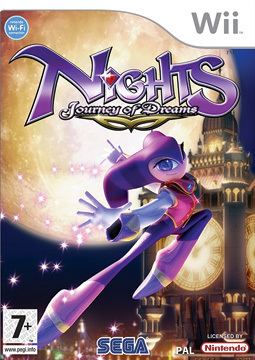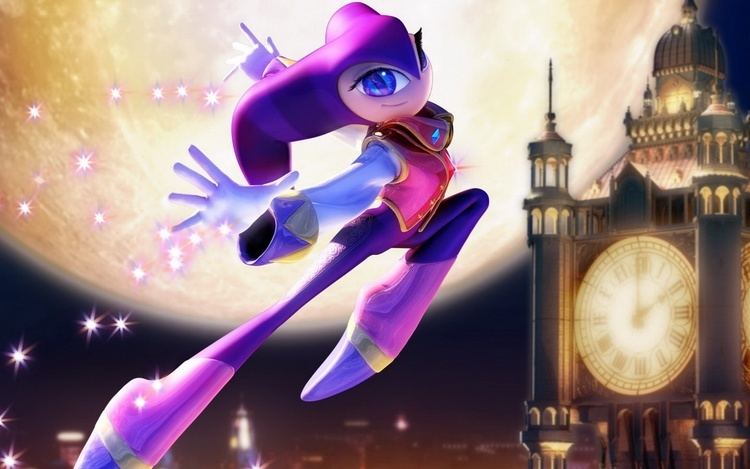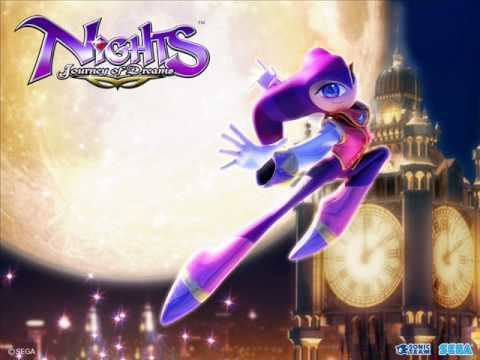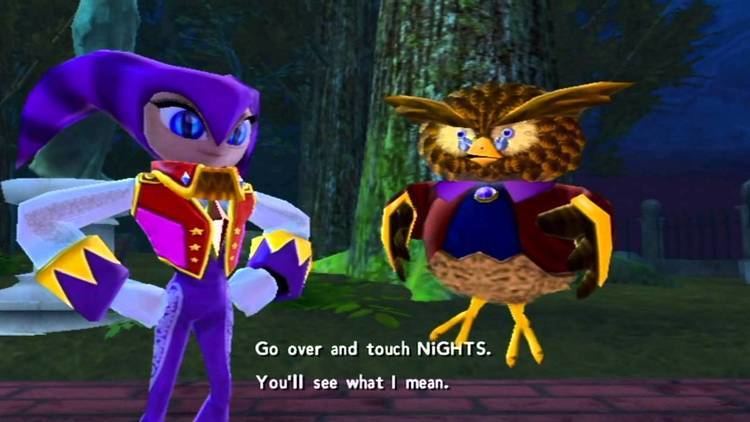6.8 /10 1 Votes6.8
69% Metacritic | 6.5/10 IGN Programmer(s) Takeshi Sakakibara Initial release date 13 December 2007 | |||||||||||||||||||||||||||||||||
 | ||||||||||||||||||||||||||||||||||
Composer(s) Tomoko SasakiNaofumi Hataya Designers Takashi Iizuka, Kazuyuki Hoshino Similar Sonic Team games, Adventure games | ||||||||||||||||||||||||||||||||||
Sgb play nights journey of dreams part 1
Nights: Journey of Dreams, stylised NiGHTS: Journey of Dreams, is an action video game developed by Sonic Team and published by Sega for the Wii. The sequel to the 1996 Sega Saturn title Nights into Dreams, it was released in Japan and North America in December 2007, and in Australia and Europe the following month. The story follows two children, Will and Helen, who enter a dream world called Nightopia. When their nightmares come to life, they enlist the help of Nights, an exiled "Nightmaren", as they journey through Nightopia to stop the evil ruler Wizeman from escaping into the real world.
Contents
- Sgb play nights journey of dreams part 1
- Nights journey of dreams wii by sega a rank hd 1080p
- Gameplay
- Setting
- Synopsis
- Prelude
- Design
- Audio
- Reception
- References

As with its predecessor, gameplay is centred around Nights flying through the dreams of the two children. The main objective of the game is to fly through rings while gathering enough keys to proceed to the next level. Development of Journey of Dreams began shortly after the release of Shadow the Hedgehog in 2005, and was headed by Sonic Team veteran Takashi Iizuka. The team took steps to ensure that the game stayed faithful to the original, while incorporating a variety of new mechanics and features. The game's setting was designed to resemble England, especially parts of London.

The game received mixed to negative reviews upon release. Critics praised the game's colourful visuals, boss battles and special effects, but most cited its poor control schemes, aesthetics and general gameplay as major flaws. Despite the negative reception, Iizuka commented that he would be interested in making a third Nights game, should the management of Sega decide to commission one. An unofficial two-CD tribute album, Nights: Lucid Dreaming, was released by OverClocked ReMix in 2011.

Nights journey of dreams wii by sega a rank hd 1080p
Gameplay
Nights: Journey of Dreams is split into seven levels. The levels are distributed equally between the two children characters: three are unique to Will, three to Helen, and both share a final boss stage. Gameplay is centred around controlling Nights' flight along a predetermined route through each level, resembling that of a 2D platformer or a racing game. In each level, players initially control Will or Helen. The player may collect various pick-ups while exploring the level on foot, but will be perused by "Awakers" which will awaken the player-character should three of them come into contact. The main objective of the game is to fly through rings and capture bird-like Nightmaren who possess keys that unlock a series of cages. There are three cages in each level, and all must be unlocked within a set time before the player can proceed. Each collision with an enemy subtracts five seconds from the time remaining, and if the time runs out, the game will end prematurely. While flying, Nights can use a boost to travel faster, but the boost meter is slowly depleted while doing this.
The game features items and traps which will either help or impede the player's progress. Collecting blue chips scattered around the levels will increase the player's score, and time chips will extend the player's time as well as slowing down "Awakers", if collected on foot. Flying through gold rings will replenish the player's boost meter, spiked rings will harm the player if flown through, and green rings will never disappear, unlike ordinary gold rings. The gameplay also involves the use of "persona masks", which will transform Nights into a different entity, thus granting new abilities to the player. There are three personas: transforming into a dolphin allows the player to swim underwater, a rocket speeds up Nights' flight, and a dragon will increase resistance to wind. Bosses are encountered twice in each level—an easier version early on in a level, and a more difficult one at the end.
The artificial life system feature from its predecessor returns in Journey of Dreams, known as "My Dream". This feature revolves around the player raising entities called Nightopians and keeping track of their moods. "My Dreams" connects with the Wii's Forecast Channel, which will change the weather conditions in the player's "My Dream" world according to real-world forecasts. Cosmetic changes are visible every month, for example in February Nightopians hold a giant dragon for the Chinese New Year, whereas in December they are dressed as Father Christmas. Players may visit other players' "My Dreams" through the Nintendo Wi-Fi Connection. In order to increase the population in a "My Dream", Nightopians must be captured in the game's story mode. If there are more Nightopians than Nightmarens in the player's "My Dream", then the environment will look more like Nightopia, however the landscape will change accordingly if there are more Nightmarens.
Journey of Dreams features four different control options: the Wii remote as a standalone controller, the Wii remote in combination with the Nunchuk, the Classic Controller, and the GameCube controller. If the Wii remote is used by itself, Nights' flight is controlled by pointing it at the screen. Additionally, the game offers two multiplayer modes: "Battle Mode" and "Speed Mode", with the latter only being playable online via Nintendo Wi-Fi Connection. "Battle Mode" allows two local players to battle each other by using a splitscreen, and "Speed Mode" revolves around players competing in races against online opponents.
Setting
Every night, all human dreams are played out in Nightopia and Nightmare, the two parts of the dream world. In Nightopia, distinct aspects of dreamers' personalities are represented by luminous coloured spheres known as "Ideya". The evil ruler of Nightmare, Wizeman the Wicked, is stealing this dream energy from sleeping visitors to gather power and take control of Nightopia and eventually the real world. To achieve this, he creates five "Nightmaren"—jester-like beings who can fly; among them are Jackle, Clawz, Gulpo, Gillwing and Puffy as well as many minor maren. He also creates two "Level One" Nightmaren: Nights and Reala. However, Nights rebels against Wizeman's plans, and is punished by being imprisoned inside an Ideya palace, a gazebo-like container for dreamers' Ideya.
Synopsis
William Taylor and Helen Cartwright are two children who live in the city of Bellbridge (a fictionalised version of London). Will is an aspiring football player, while Helen is a prodigy violinist. Over the years, both have grown apart from their respective parents; Helen has chosen to spend more time practising the violin with her friends rather than with her mother, a choice which has begun to fill her with guilt, while Will's father is transferred to another city for work and leaves his son by himself. Both children suffer nightmares and come under attack by the Nightmaren, who chase them into the world of Nightopia. There, the two children separately meet Nights, who has the ability to merge with the children, allowing them to share Nights' body and fly through the skies. Learning that Wizeman is plotting to take over the dream world and consequently enter the real world, the children and Nights resolve to stop Wizeman, but face hindrance from the Nightmaren he commands, particularly Nights' sibling, Reala.
Though different, children's stories share similar structures. The story reaches its climax as a stairway appears at the Dream Gate and Helen and Nights ascend, only to be trapped by Wizeman himself and pulled into darkness. Will arrives too late and dives in after them, arriving in the night skies above Bellbridge, where he finds that he now has the ability to fly alone without Nights using their Ideya. He rescues Helen, and the two attempt to save Nights, who has been imprisoned at the top of Bellbridge's clock tower. Reala appears to stop their efforts and accepts Nights' challenge to battle. After defeating Reala, the trio prepare to face Wizeman. Both Will and Helen defeat Wizeman, and is subsequently destroyed. Since Wizeman keeps all of his creations alive, Nights vanishes in a white light, bowing as if it were the end of a performance, and the children wake up crying. That evening, Helen plays her violin for her mother in a crowded hall, while Will celebrates with his father after winning a football game. He then loses the ball and goes after it, only to come upon Helen playing her violin. The lights suffer a temporary blackout, and when they turn back on, Helen sees Will extending a friendly hand to her. Recognising each other from their adventures in Nightopia, the two reach for each other as it begins to snow. The final scene is of either child sleeping in their rooms at home as the camera pulls back towards Bellbridge's clock tower, where Nights is seen to still be alive, and peacefully watching over the city from atop it.
Prelude
A sequel to Nights into Dreams with the working title Air Nights was originally outlined for the Saturn and subsequently developed for the Dreamcast with motion control being a central element of gameplay. In an August 1999 interview, Yuji Naka confirmed that a sequel was in development; by December 2000, however, the project had been cancelled. Naka expressed reluctance to develop a sequel after the Dreamcast's demise, but later noted in 2003 that he would be interested in using the licence of Nights into Dreams to reinforce Sega's identity. Discussion concerning a new game in the series had increased in frequency by 2006. Rumours regarding a Wii version continued to appear when a list of upcoming games was published by Japanese developer G.rev, which included an unspecified Nights title. Before the development of Journey of Dreams, Naka confirmed in retrospective interviews that he had intended to base the next Nights game around a "special controller interface".
Design
Nights: Journey of Dreams was first conceptualised in November 2005 after Shadow the Hedgehog was shipped. Game design was primarily prepared by Takashi Iizuka and took around six months before the actual development process begun. Iizuka wanted to ensure that the next Nights game would stay faithful to the original, and felt the need to keep the game's concept fundamentally the same whilst also incorporating a variety of new mechanics. Despite the cancellation of Air Nights, Iizuka stressed that he had always wanted to create a sequel and asserted that the discontinuation of Sega's hardware manufacturing had no effect on the delay of the awaiting title. Iizuka also felt that it was the appropriate time to release a Nights game, as he thought the industry was dominated by violence, and as such, wanted to release a more family-friendly title. The team realised that the upcoming Wii was marketed as a family-orientated console, and also factored in its online features and user-friendly design.
The team wanted Journey of Dreams to revolve around a dramatic storyline in hopes that the player would find it more engaging and intuitive, as Iizuka thought the original Nights into Dreams was not user-friendly. Originally, the game had a full free-roaming 3D flight system, but Iizuka thought it was too complex and "not as fun" as the core flight element featured in the original game. Iizuka thought the most difficult challenge of the development process was keeping the game's flight mechanics fun whilst building upon elements of the original game. To recreate the experience, the team tested a variety of controller schemes which included the Wii remote and Nunchuk, the GameCube controller, and the Classic Controller—the latter two left for players who preferred using a traditional controller configuration. Initially, the game used the Wii remote by having the player point it at the screen, but the team discovered that its motion sensors would not pick up small movements, so Iizuka created an alternative hybrid motion-pointer system, which he believed would retain the game's fun-to-fly experience. According to Iizuka, the entire game was created from scratch and used a new engine specifically designed for the Wii.
Sonic Team decided to give all characters in the game voices, with Iizuka affirming that full dialogue helps add depth to both the story and gameplay. With Nights already designed as an androgynous character, the team wanted to leave impressions regarding gender up to the player, despite Nights having a female voice in the game. The team also took steps to ensure that the Nights franchise was designed to have a British style, whereas in contrast, the character of Sonic the Hedgehog was designed to be more American. As such, the city of Bellbridge—the game's main setting— closely resembles London, and all of the game's characters have English accents. The development team consisted of 26 members of Sonic Team in the United States, while all sound work and CGI was developed in Japan.
In 2010, Iizuka commented that he would be interested in making a third Nights game, should the management of Sega decide to commission one.
Audio
Tomoko Sasaki reprised her role of lead composer from the original Nights into Dreams, and was rejoined by Sonic Team veterans Naofumi Hataya and Fumie Kumatani. Additionally, series newcomers Tomoya Ohtani, Teruhiko Nakagawa, and Tatsuyuki Maeda each contributed a few musical pieces. The game's sound effects were created primarily by Jun Senoue, better known for his musical compositions in the Sonic the Hedgehog series. According to producer Takashi Iizuka, the team understood that they could not compose the same style of music featured in the original game, due to Journey of Dreams being "completely revamped" technically. Sasaki elaborated that the original Saturn version used the console's internal music sequencer, which allowed them more control over changing the game's music as the player progressed through the game, whereas the Wii version only played the recorded music directly. Despite the limitations, both Sasaki and Hataya were able to produce a better quality soundtrack by using a wider range of instruments than what was used in the previous game. In addition, Sasaki asked an employee from Delfi Sound Inc. to record an orchestral music for the game. Since the team were aware that the game's characters would have more dialogue than the original game, they requested that the orchestra perform a dramatic arrangement in order to put more emphasis on the game's storyline.
To make the development process as smooth as possible, Hataya tried to work in the same environment as Sasaki so that they could exchange data more efficiently. The main tools and software used during development were Digital Performer and Pro Tools, which—according to Hataya—were the standard tools used in music production. In order to stress that the atmosphere of Journey of Dreams was centred around surrealism and dreams themselves, Sasaki discarded tying the game's music down to a single genre and took the approach of not having a clear musical policy. Sasaki also ensured that each theme included the exhilaration of "flying in the air", as it was a core element of gameplay. Hataya echoed that the music of the game was produced by focusing on being able to empathise with the feeling of flying, as well as to exemplify the game's atmosphere and characters. Since the team were aware that Journey of Dreams had a greater sense of adventure than the original, the team knew that they could incorporate a larger variety of music into it so that players would enjoy a wider range of emotions. In addition to composing the music itself, Hataya took the responsibility of re-arranging Sasaki's music in different ways so that the theme matched the in-game situation. According to Hataya, both he and Sasaki produced around 70 percent of the game's music, whereas the rest was produced by Sega's sound team.
Nights: Journey Of Dreams: Original Soundtrack was released on 26 January 2008 exclusively in Japan and contains three separate CDs with all of the music featured on the Wii version. An unofficial two-CD tribute album, Nights: Lucid Dreaming, was released by OverClocked ReMix in 2011. There are 25 tracks in total, with arrangements of the game's original soundtrack in a variety of styles. In January 2017, over 50 songs from the game and its predecessor, Nights into Dreams, became available to download on Spotify.
Reception
Nights: Journey of Dreams received mixed reviews upon release. It holds an aggregate score of 69% at GameRankings, based on an average of 49 reviews.
Most critics praised the game's colourful visuals and special effects. Chris Scullion from the Official Nintendo Magazine thought the game aesthetically had all of the speed and charm of the original, and also enjoyed its "lush" atmosphere and landscapes. Kevin VanOrd of GameSpot similarly appreciated the game's artistic design, visual "dreaminess" and elegance, and Gerald Villoria of GameSpy liked the game's colourful and vibrant levels. Nintendo Life's Anthony Dickens praised the general visual style of the game; noting that its boss battles particularly "ooze" with bright and exotic colours. Despite the general praise of the game's colourful palette, some critics viewed the aesthetics unfavourably. GameZone's Louis Bedigan felt that Nights: Journey of Dreams lacked the "eye-popping effects" of other contemporaries such as Super Mario Galaxy and Twilight Princess, and Dickens opined that the game's custcenes were more akin to PlayStation 2 titles. Tom Bramwell from Eurogamer felt that the environments looked like they were from 1996, despite the attempts made to distract the player from the game's simple premise. Paul Govan of GamesTM found that the game engine struggled to match the cutscene's visual fluidity with its actual gameplay, and expressed disappointment that Wii owners would be unfazed by its graphical prowess, unlike Sega Saturn owners were at the time of the original Nights into Dreams release. Dickens thought the game was graphically rushed by Sega, and speculated that it was "cobbled together quickly" by artists who had focused too much on designing the game's introduction sequence. Adam Rosenberg from UGO Networks found the graphics to be a disappointment, saying that its environments were "drab" considering it was based on the dreams of twelve year old children, and also noticed frame rate issues. Likewise, two reviewers from Electronic Gaming Monthly, Shane Bettenhausen and Sam Kennedy, thought the 3D was "amateurish" and suffered from basic issues including uneven graphics and unskippable cutscenes.
Some reviewers criticised various aspects of gameplay, in particular the lack of checkpoints. Scullion noted how the game retained its "old school" feeling despite being aimed at a new audience, and disliked its "die, retry" style of gameplay which he considered old-fashioned. Mark Bozon from IGN similarly criticised the game's tendencies to make the player restart an entire level upon death, calling it "a momentum killer", and Rosenberg labelled the automatic restarts as the game's "worst offender". Most reviewers praised the eccentricity and fun-factor of the boss battles; VanOrd believed the boss fights were enjoyable and memorable, and Jeuxvideo.com's reviewer liked the bosses' appearances and originality, but found defeating them more than once in each world too repetitive. In contrast, Bramwell thought that the game's boss characters channelled a mix between Tim Burton and CBeebies, and Bozon felt that boss battles did not blend well with the main story due to them being in self-contained arenas.
Reviewers condemned the game's control scheme, with most reviewers asserting that the use of the Wii remote was awkward and difficult to harness. Bozon condemned the lack of refined flight control and noted that it was easier to use either the Classic Controller or the GameCube controller despite there not being any motion, infrared, or tilt features. Simarily, Scullion declared that out of the three control schemes, the Wii remote was the least accurate option. VanOrd echoed the poorly implemented use of the Wii remote, and Rosenberg thought its controls were overly responsive and unpolished—both reviewers recommended using the Classic Controller's analogue stick as an alternative. Dickens recognised that the original Nights into Dreams was one of the first games benefit from an analogue stick, and was therefore surprised at how Nights: Journey of Dreams had a "control scheme crisis" bolstered by the fact that it offered multiple control schemes which might add confusion for new players. Govan suggested that the reason why the game featured alternative control schemes was due to the fact that Sonic Team wanted to emulate the original Saturn controls. In contrast, the reviewer from Jeuxvideo.com found little fault with any of the game's control schemes, and Bedigan labelled them as "excellent". Both reviewers, however, agreed that the Wii remote's motion controls did not work well with the game.
